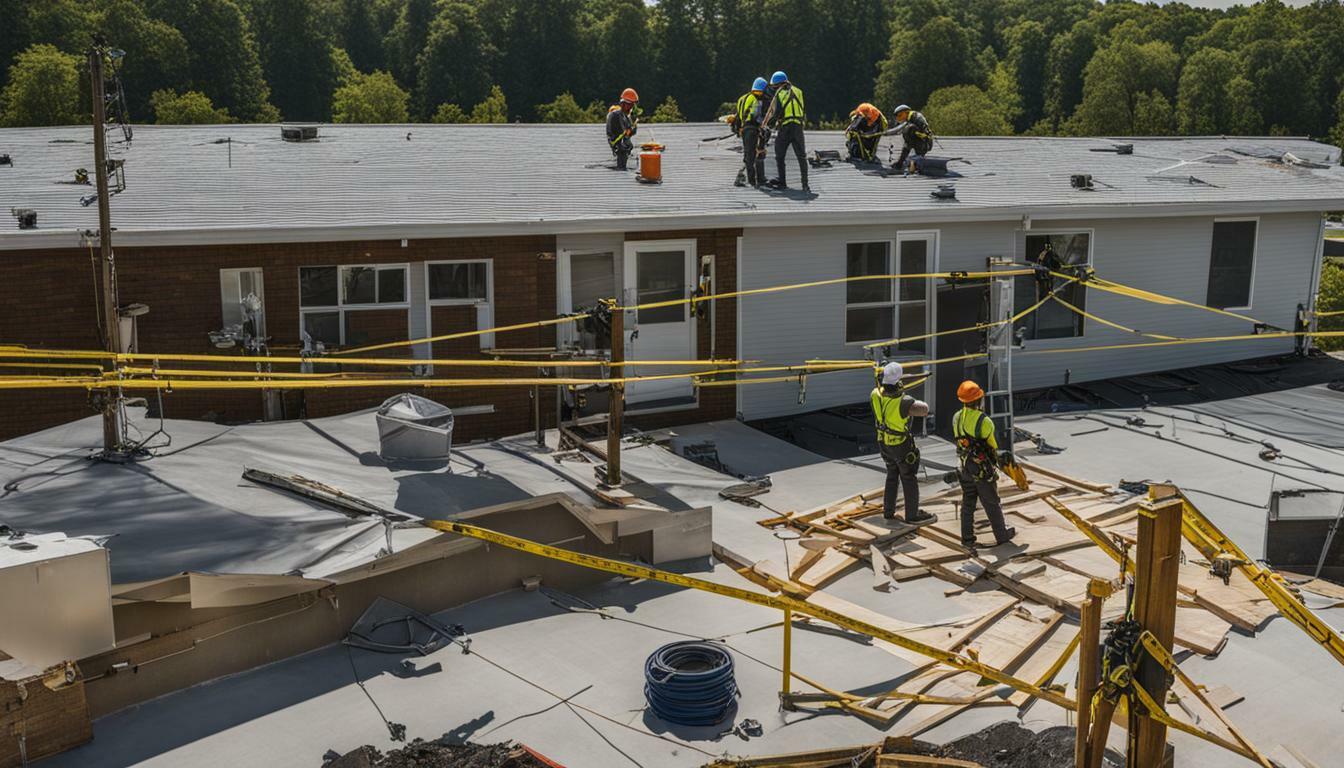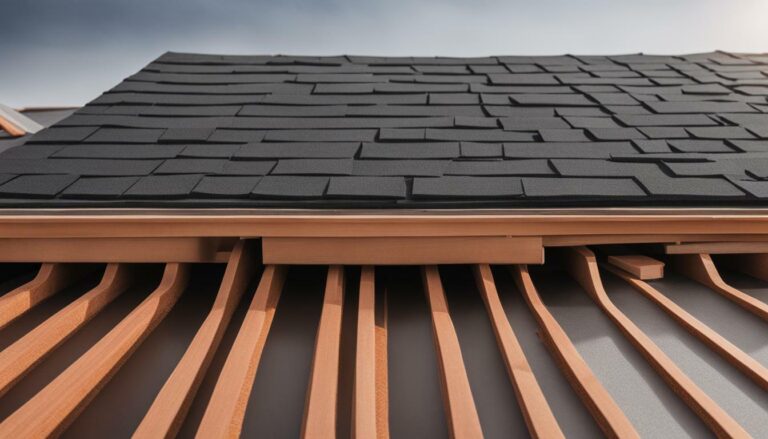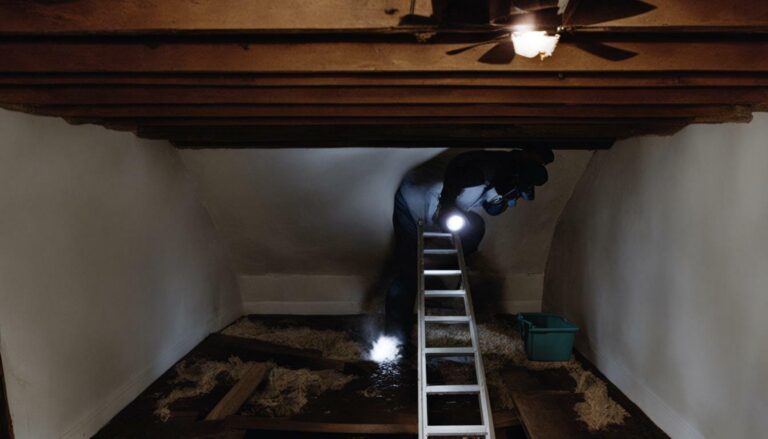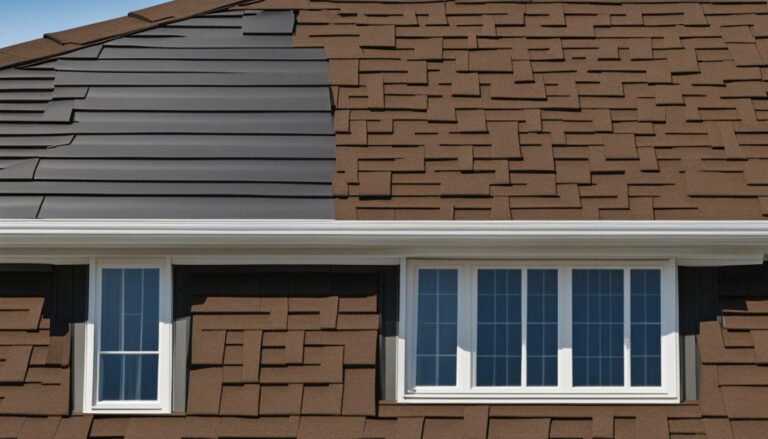Ensure Your Safety with These Roof Safety Precautions
Roof safety precautions are essential to protect yourself from potential hazards and accidents when working on roofs. Whether you are a professional roofer or a homeowner attempting a DIY repair, it is crucial to prioritize safety at all times. By implementing the following tips and guidelines, you can ensure your safety and minimize the risk of injury:
Key Takeaways:
- Use common sense and assess risks before starting any work on the roof
- Avoid working on roofs during bad weather conditions
- Invest in high-quality ladders and avoid using cheap alternatives
- Dress accordingly and wear proper footwear to protect yourself
- Wear a helmet to protect your head from potential accidents or falling objects
Implement a roof safety harness for effective fall protection
- Create designated walkway paths on the roof to promote safe movement
- Implement comprehensive policies and procedures for consistent adherence to safety guidelines
- Avoid consuming alcohol and distractions like using your phone while working on roofs
- Follow ladder safety guidelines provided by the U.S. Department of Labor’s Occupational Safety and Health Administration
- Pay attention to electrical safety, nail gun safety, and safety when handling materials on the roof
By following these roof safety precautions, you can significantly reduce the risk of accidents and protect yourself from serious injury or even death. Prioritizing safety should always be the first step when working on roofs.
Use Common Sense
When working on a roof, it is crucial to use your common sense and exercise caution at all times. Roof safety precautions should always be a top priority to protect yourself from accidents and potential injuries. Here are some important roof safety tips and guidelines to keep in mind:
- Assess the risks: Before starting any work on the roof, carefully assess the potential hazards and risks involved. Look out for loose or slippery surfaces, nearby power lines, and other obstacles that may pose a threat.
- Plan your approach: Create a plan for accessing and moving around the roof safely. Use designated walkway paths whenever possible and avoid stepping on fragile or unstable areas.
- Use proper equipment: Always use high-quality safety equipment, such as harnesses, hard hats, and non-slip footwear. These items can provide vital protection and prevent serious injuries in case of a fall or accident.
- Stay aware of the weather: Avoid working on the roof during bad weather conditions, such as heavy rain, strong winds, or thunderstorms. These conditions can make the roof surface slippery and increase the risk of accidents.
By following these roof safety precautions and using your common sense, you can ensure a safer working environment and minimize the chances of accidents or injuries. Remember, your safety should always be the top priority when working on roofs.
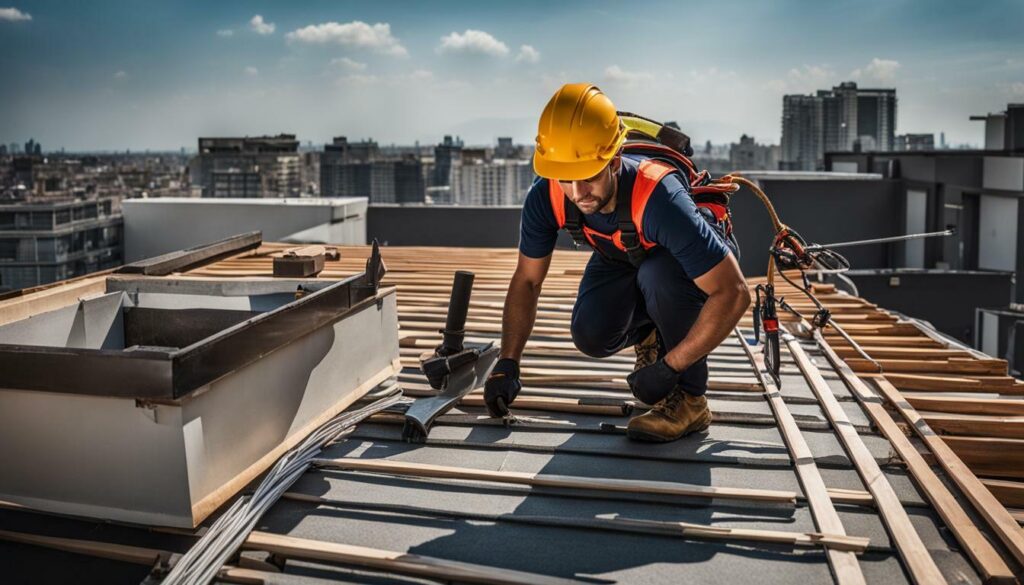
To further enhance your understanding of ladder safety, here are some guidelines provided by the U.S. Department of Labor’s Occupational Safety and Health Administration (OSHA):
| Ladder Safety Tips |
|---|
| Always inspect the ladder for any damage or defects before use. |
| Ensure the ladder is positioned on a stable and level surface. |
| Avoid overreaching or leaning too far to maintain balance. |
| Do not use ladders near power lines or electrical equipment. |
| When ascending or descending, maintain three points of contact with the ladder (e.g., two hands and one foot or two feet and one hand). |
| Be cautious of any obstructions or hazards that may interfere with the ladder’s stability. |
Remember to always prioritize safety and follow established guidelines when working on a roof or using ladders. These precautions can significantly reduce the risk of accidents and ensure a safe working environment.
Avoid Working in Bad Weather
Working on a roof during bad weather conditions can be extremely dangerous, so it is advisable to avoid such situations altogether. Rain, strong winds, snow, or icy conditions can create hazardous conditions that increase the risk of accidents and injuries. Therefore, it is crucial to prioritize your safety and postpone any roofing work until the weather improves.
Bad weather can make the roof surface slippery, making it challenging to maintain balance and stability. This increases the risk of falls, which can result in severe injuries or even fatalities. Additionally, wet or icy surfaces can affect the structural integrity of the roof, making it more susceptible to damage or collapse.
When planning roofing work, closely monitor weather forecasts and reschedule any tasks if adverse weather conditions are expected. It is essential to prioritize safety over strict timelines or deadlines. Protecting yourself and your team from potential hazards should be the top priority.
Roof Safety Tips During Bad Weather
Here are some essential tips to keep in mind to ensure your safety during bad weather:
- Avoid working on the roof during heavy rain, storms, strong winds, snowfall, or icy conditions.
- Monitor weather forecasts and plan your roofing work accordingly.
- If you encounter unexpected bad weather while working on the roof, immediately seek shelter and secure all tools and equipment to prevent them from being blown away or causing damage.
- Inspect the roof for any signs of damage after severe weather conditions have passed, and consult a professional if any repairs are necessary.
By following these roof safety guidelines and avoiding work during bad weather, you can significantly reduce the risk of accidents and ensure the well-being of everyone involved in the roofing project.
| Roof Safety Precautions | Roof Safety Tips |
|---|---|
| Avoid working on the roof during bad weather conditions | Avoid heavy rain, storms, strong winds, snowfall, or icy conditions |
| Use common sense when working on roofs | Assess risks, make informed decisions |
| Avoid using cheap ladders | Invest in high-quality ladders for ladder safety |
| Dress accordingly and wear proper footwear | Protect yourself with appropriate clothing and footwear |
| Protect your head with a helmet | Wear a helmet to prevent head injuries |
| Use a roof safety harness | Ensure fall protection with a safety harness |
| Create walkway paths on the roof | Minimize the risk of accidents by establishing safe paths |
| Implement policies & procedures | Ensure consistent adherence to roof safety guidelines |
| Avoid alcohol and distractions | Avoid consuming alcohol and using mobile phones |
Remember, proper roofing safety precautions are essential to avoid serious injury or death. By following the recommended guidelines and tips, you can create a safe working environment and protect yourself and your team from potential hazards.

Using cheap ladders when working on a roof can lead to accidents and injuries, making it vital to choose high-quality and sturdy ladders. Cheap ladders are often made from inferior materials, compromising their stability and posing a significant risk to your safety. To ensure ladder safety for roofs, it is essential to invest in ladders that meet safety standards and are specifically designed for working at heights.
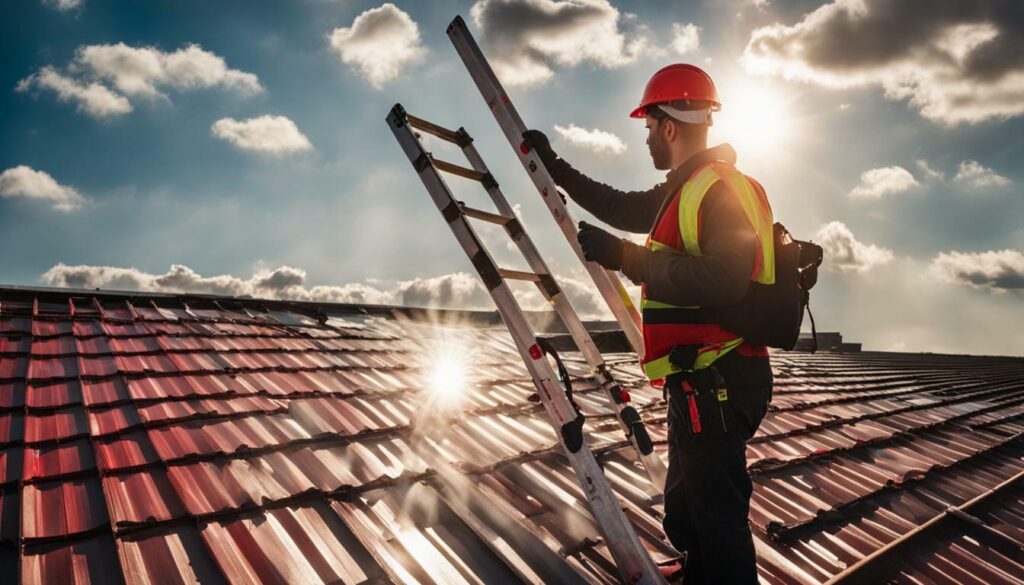
When selecting a ladder, consider its weight capacity, durability, and stability. A ladder with a higher weight capacity will provide added support and reduce the risk of collapsing under your weight. Look for ladders made from materials such as aluminum or fiberglass, as they offer excellent strength and resistance to weather conditions.
Furthermore, inspect your ladder before each use to ensure it is in good condition. Check for any signs of damage, such as bent rungs or loose joints. If you notice any issues, refrain from using the ladder and have it repaired or replaced immediately.
In addition to using high-quality ladders, it is crucial to follow proper ladder safety guidelines, such as positioning the ladder correctly, securing it at the top and bottom, and maintaining three points of contact while climbing. By adhering to these precautions, you can significantly reduce the risk of falls and injuries when working on roofs.
Benefits of Using High-Quality Ladders:
- Increased stability and reliability
- Reduced risk of ladder collapse
- Enhanced safety when climbing and descending
- Longer lifespan, resulting in cost savings
- Compliance with safety regulations
| Material | Benefits |
|---|---|
| Aluminum | Lightweight, corrosion-resistant, and easy to transport |
| Fiberglass | Non-conductive, suitable for electrical work, and durable |
Choosing a high-quality ladder is an investment in your safety. Don’t compromise on your well-being by using cheap ladders that can lead to accidents and injuries.
Dress Accordingly and Wear Proper Footwear
When working on a roof, it is essential to dress appropriately and wear the right footwear to ensure maximum safety and comfort. Proper attire and suitable shoes can greatly minimize the risk of accidents and injuries. Here are some roof safety guidelines to follow:
- Choose the right clothing: Wear long-sleeved shirts and long pants made of durable and breathable materials to protect your skin from sharp objects, extreme temperatures, and harmful UV rays. Avoid loose-fitting clothing that may get caught in equipment or obstruct your movement.
- Invest in sturdy footwear: Opt for slip-resistant, closed-toe shoes or boots with good traction. They should provide ankle support and have a solid grip to prevent slips and falls. Avoid wearing sandals, flip-flops, or any footwear that exposes your feet to potential hazards.
- Consider wearing knee pads: If your work involves kneeling or crawling on the roof, it’s advisable to wear knee pads for added protection and comfort. They can help reduce strain on your knees and prevent injuries.
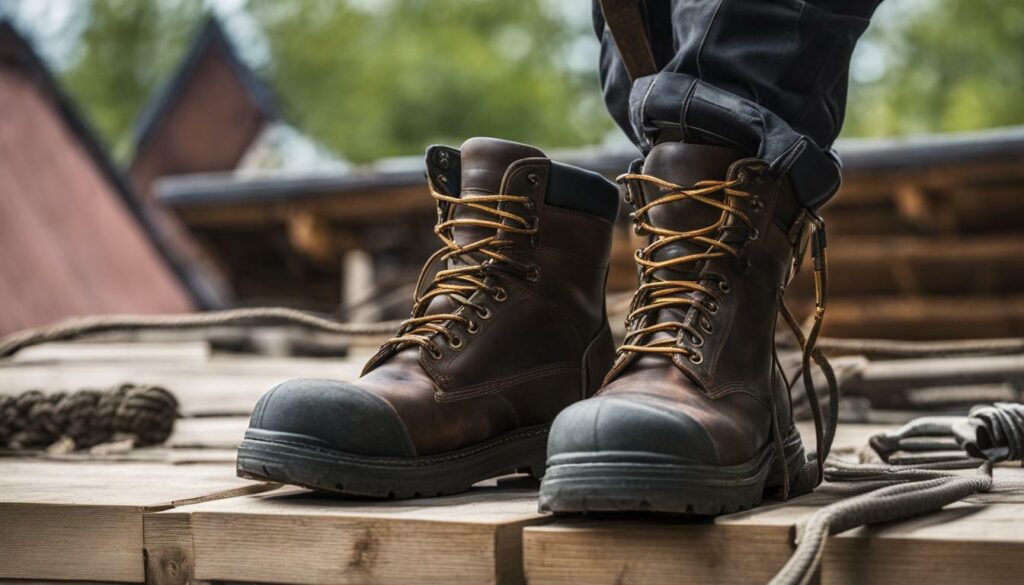
“Proper roofing safety precautions should be taken to avoid serious injury or death. When working on a roof, it is essential to dress appropriately and wear the right footwear to ensure maximum safety and comfort.”
Remember, your safety should always be a top priority when working on roofs. By following these roof safety precautions and guidelines, you can greatly reduce the risk of accidents and create a safer working environment for yourself and others.
Additional Resources:
For more detailed information on ladder safety, you can refer to the ladder safety guidelines provided by the U.S. Department of Labor’s Occupational Safety and Health Administration (OSHA). These guidelines offer comprehensive safety measures and best practices for using ladders on roofs and other elevated surfaces.
| Resource | Link |
|---|---|
| OSHA Ladder Safety Guidelines | https://www.osha.gov/Publications/ladders/index.html |
Protect Your Head with a Helmet
Wearing a helmet is an important safety measure that can significantly reduce the risk of head injuries while working on a roof. Whether you are a professional roofer or a DIY enthusiast, it is crucial to prioritize your safety by wearing a helmet that meets the required safety standards.
A helmet designed specifically for roofing work provides protection against falling objects, bumps, and falls. It serves as a barrier between your head and potential hazards, shielding you from serious head injuries that can occur while working at heights. Investing in a high-quality helmet is a small price to pay for the peace of mind and protection it offers.
When choosing a helmet, look for safety certifications such as the ANSI (American National Standards Institute) and OSHA (Occupational Safety and Health Administration) standards. These certifications ensure that the helmet meets rigorous safety requirements and will provide reliable protection in hazardous situations.
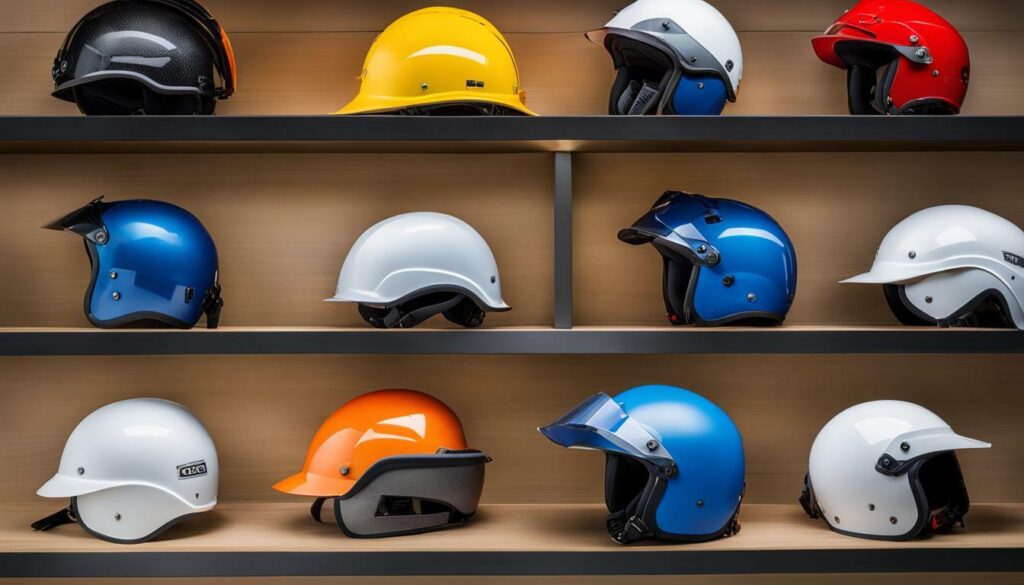
Remember, accidents can happen even to the most experienced professionals. By wearing a helmet, you are taking a proactive step towards safeguarding your head and minimizing the risk of severe injuries. Prioritize your safety by making a helmet an integral part of your roof safety gear.
Use a Roof Safety Harness
Implementing a roof safety harness is crucial to prevent falls and provide adequate protection while working on a roof. A roof safety harness consists of a full-body harness, anchor points, and a lanyard or lifeline to secure the worker to a stable structure. This safety equipment is designed to distribute the force of a fall across the body, reducing the risk of injury.
According to the U.S. Department of Labor’s Occupational Safety and Health Administration, a roof safety harness should meet specific requirements to ensure its effectiveness. The harness should be properly fitted, with shoulder straps snugly in place and leg straps adjusted to prevent excessive movement. The anchor points should be securely attached to a load-bearing structure, and the lanyard or lifeline should have a shock-absorbing feature to reduce force if a fall occurs.
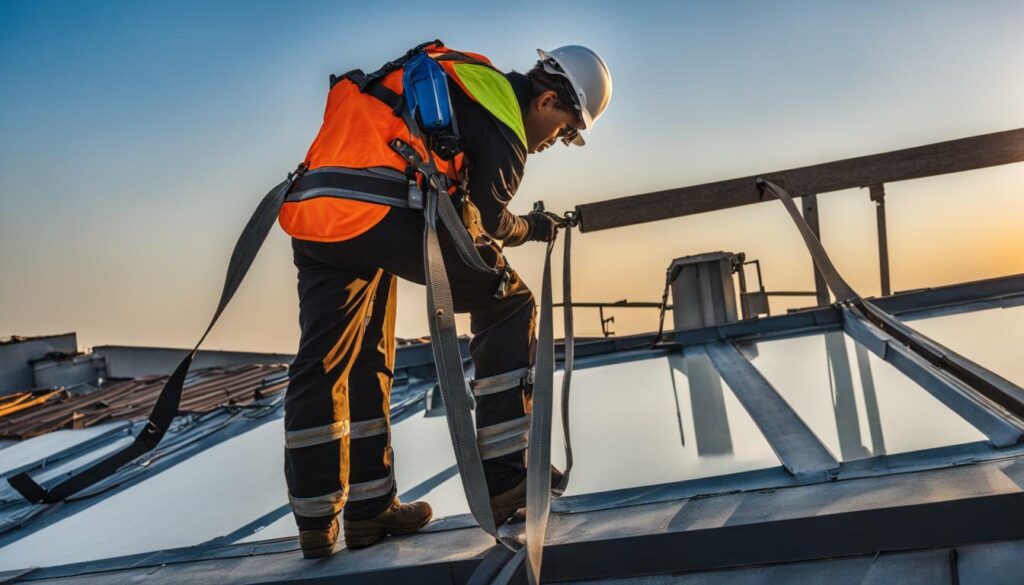
When using a roof safety harness, it is essential to inspect all components before each use. Check for any signs of wear, fraying, or damage that may impact the harness’s performance. Additionally, ensure that the anchor points are structurally sound and capable of supporting the weight of the worker in the event of a fall.
| Benefits of a Roof Safety Harness |
|---|
| Prevents falls from heights |
| Distributes force of a fall across the body |
| Reduces the risk of injury |
| Complies with safety regulations and standards |
Remember, working on a roof can be dangerous, and proper safety precautions should always be taken. Using a roof safety harness is just one of the many measures you should implement to protect yourself and ensure a safe working environment. By following the guidelines and utilizing the appropriate safety equipment, you can minimize the risk of accidents and injuries while working on roofs.
Create Walkway Paths
Establishing designated walkway paths on the roof can significantly enhance safety by reducing the chances of tripping or falling. These paths should be clearly marked and free from any debris or obstructions. By creating a safe and clearly defined route, workers can move around the roof with ease and minimize the risk of accidents.
When designing walkway paths, it’s important to consider the layout and structure of the roof. Identify the areas where workers are most likely to access and navigate frequently, such as equipment installations or maintenance points. By focusing on these high-traffic areas, you can prioritize safety and ensure that workers have a clear path to follow.
One effective way to create walkway paths is to use roof walk pads or mats. These slip-resistant and durable mats provide a stable surface for workers to walk on, even during wet conditions. Additionally, they can help protect the roof surface from damage caused by foot traffic.
| Benefits of Walkway Paths | Implementation Tips |
|---|---|
|
|
Remember, a well-designed walkway path system is an essential component of roof safety guidelines. By implementing these measures, you can enhance safety, minimize accidents, and ensure a secure working environment for all workers.

Instituting well-defined policies and procedures is vital to create a culture of safety and ensure that all workers follow roof safety guidelines. By establishing clear guidelines, employers can reduce the risk of accidents and injuries on the job. These policies should outline the necessary safety precautions that workers must adhere to when working on roofs.
One essential policy is the requirement for all workers to undergo proper training on roof safety guidelines and procedures. This training should cover topics such as ladder safety, fall protection, and the use of personal protective equipment. Providing comprehensive training ensures that workers are equipped with the knowledge and skills necessary to carry out their tasks safely.
Moreover, these policies should emphasize the importance of conducting regular inspections and maintenance of roof safety equipment. This includes inspecting ladders, harnesses, and helmets for any signs of wear or damage. Regular inspections help identify potential hazards and ensure that all equipment is in proper working condition.
Sample Table: Roof Safety Training Topics
| Training Topic | Description |
|---|---|
| Ladder Safety | Proper ladder selection, setup, and safe climbing techniques |
| Fall Protection | Understanding and utilizing fall protection equipment, such as harnesses and anchor points |
| Personal Protective Equipment | Proper use of helmets, gloves, and other protective gear |
| Electrical Safety | Precautions when working near electrical lines or equipment |
| Material Handling | Safely handling and transporting materials on the roof |
By implementing these policies and procedures, employers demonstrate their commitment to ensuring a safe working environment. Regularly reinforcing these guidelines through training sessions, safety meetings, and ongoing communication further emphasizes the importance of roof safety precautions. When workers understand the significance of following these guidelines and have the necessary tools and knowledge, they can confidently carry out their tasks while prioritizing their own safety.
Avoid Alcohol and Distractions
It is crucial to refrain from consuming alcohol and eliminate distractions like using your phone when working on a roof to maintain focus and prevent accidents. Working at heights already poses inherent risks, and impaired judgment or loss of concentration due to alcohol or distractions can significantly increase the likelihood of a dangerous incident occurring. By adhering to roof safety guidelines, you can prioritize your well-being and ensure a safe working environment.
“Alcohol and drugs impair your judgment, balance, and coordination, as well as your ability to respond quickly. They also affect your body’s ability to regulate its own temperature and can often lead to dizziness or disorientation, which is particularly dangerous when working at heights,” warns the U.S. Department of Labor’s Occupational Safety and Health Administration. To avoid putting yourself and others at risk, it is crucial to abstain from alcohol consumption before undertaking any roofing tasks.
Moreover, distractions like using your phone or engaging in other activities unrelated to the task at hand can divert your attention from potential hazards on the roof. One moment of inattention can lead to a severe fall or injury. Keep your focus solely on the job, and if necessary, put your phone on silent or out of reach until the work is complete.
| Key Points |
|---|
| Avoid consuming alcohol before working on the roof. Impaired judgment and coordination can lead to accidents. |
| Eliminate distractions like using your phone. Maintaining focus is crucial for a safe working environment. |
| Abstaining from alcohol and avoiding distractions will help ensure your safety and the safety of others. |
Remember, the highest priority when working on a roof is your safety. By following roof safety precautions, including avoiding alcohol and distractions, you can minimize the risk of accidents and maintain a secure working environment.
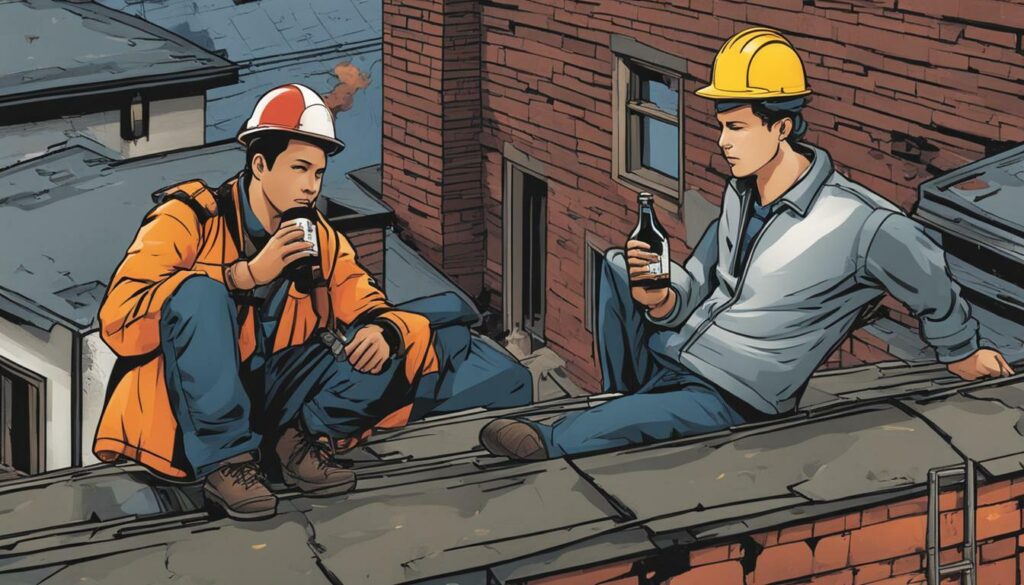
Additional Safety Considerations
Apart from the general roof safety precautions, it is essential to be aware of other potential hazards related to electricity, nail guns, and materials on the roof. Taking proper precautions when dealing with these specific risks is crucial to ensure the safety of yourself and others.
Electrical Safety
When working on the roof, it is important to be cautious around electrical components. Before starting any work, make sure to identify and turn off any electrical sources that may pose a risk. Avoid contact with exposed wires and always use insulated tools when working around electrical equipment. If you are unsure about the electrical safety measures, consult a professional electrician.
Nail Gun Safety
Nail guns are commonly used in roofing projects, but they can be dangerous if not used properly. Always handle nail guns with care, keeping your finger off the trigger until you are ready to shoot. Be mindful of your surroundings and avoid pointing the nail gun at yourself or others. Familiarize yourself with the manufacturer’s instructions and wear appropriate protective gear, such as safety glasses, to minimize the risk of accidents.
Safety When Handling Materials on the Roof
Roofing materials can be heavy and cumbersome, posing a risk of injury if not handled properly. When carrying materials onto the roof, make sure to use proper lifting techniques, bending your knees and keeping your back straight. If working with larger materials, such as plywood or shingles, ask for assistance to avoid strain or accidents. Additionally, ensure that materials are securely stacked and stored, reducing the risk of them falling or sliding off the roof.
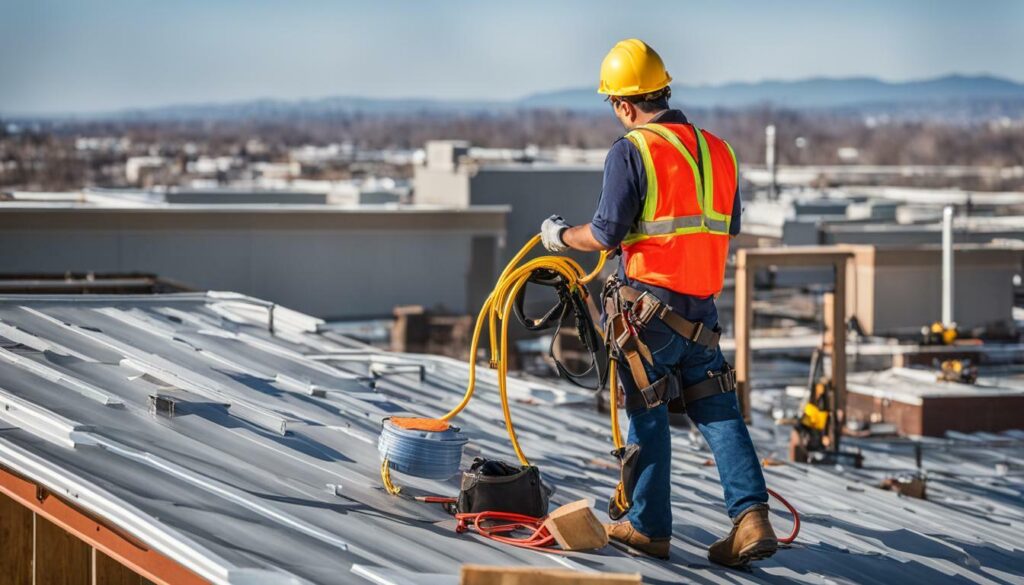
| Electrical Safety Tips | Nail Gun Safety Tips | Safety When Handling Materials |
|---|---|---|
|
|
|
Remember, taking appropriate safety measures when working with electricity, nail guns, and materials on the roof is crucial to avoid serious injury or even death. Always prioritize safety and follow the recommended guidelines to ensure a safe and successful roofing project.
Conclusion
Prioritizing your safety by implementing these roof safety precautions can help prevent serious injuries or even fatal accidents while working on roofs. By using common sense and assessing risks, you can make informed decisions to ensure your safety. It is crucial to avoid working on roofs during bad weather conditions to minimize the risk of accidents.
Investing in high-quality ladders and avoiding cheap alternatives is essential for ladder safety on roofs. Dressing accordingly and wearing proper footwear can protect you from potential hazards and ensure your comfort while working on roofs. Additionally, wearing a helmet can protect your head from potential falling objects or accidents on the roof.
Using a roof safety harness is an effective fall protection measure and should be used when working on roofs. Creating walkway paths on the roof promotes safe movement and minimizes the risk of accidents. Implementing comprehensive policies and procedures ensures consistent adherence to roof safety guidelines and helps maintain a safe working environment.
Avoiding alcohol consumption and distractions, such as using mobile phones, is crucial to maintaining focus and preventing accidents on the roof. It is important to consider additional safety measures, such as electrical safety, nail gun safety, and safety when handling materials on the roof. These precautions, along with the guidelines provided by the U.S. Department of Labor’s Occupational Safety and Health Administration for ladder safety, can further enhance your safety while working on roofs.
FAQ
Q: What are some roof safety precautions?
A: Some roof safety precautions include using common sense, avoiding working in bad weather, avoiding using cheap ladders, dressing accordingly and wearing proper footwear, protecting your head with a helmet, using a roof safety harness, creating walkway paths, implementing policies and procedures, avoiding alcohol before working on the roof, and avoiding distractions like using your phone.
Q: Why is it important to use common sense when working on roofs?
A: Using common sense when working on roofs is important as it helps you assess risks, make informed decisions, and prioritize your safety.
Q: Why should you avoid working in bad weather?
A: Working in bad weather increases the risk of accidents, as slippery surfaces and poor visibility can make roof work more dangerous. It is best to wait for suitable weather conditions to ensure your safety.
Q: Why should you avoid using cheap ladders?
A: Using cheap ladders can compromise ladder safety, increasing the risk of falls and accidents. Investing in high-quality ladders ensures stability and reduces the chances of injury when working on roofs.
Q: Why is it important to dress accordingly and wear proper footwear?
A: Dressing appropriately and wearing proper footwear protects you from potential hazards on the roof, such as sharp objects, extreme temperatures, and slippery surfaces. It enhances your safety and reduces the risk of injuries.
Q: Why should you protect your head with a helmet?
A: Wearing a helmet protects your head from potential falling objects or accidents on the roof. It is a crucial safety measure to prevent serious head injuries.
Q: Why is using a roof safety harness important?
A: Using a roof safety harness provides fall protection when working on roofs. It prevents falls and ensures your safety by keeping you securely attached to the roof structure.
Q: Why is it important to create walkway paths on the roof?
A: Creating walkway paths on the roof promotes safe movement and helps avoid accidental slips and falls. It allows for organized access and minimizes the risk of accidents.
Q: Why should policies and procedures be implemented?
A: Implementing comprehensive policies and procedures ensures consistent adherence to roof safety guidelines. It establishes clear protocols for safety measures and helps minimize the risk of accidents.
Q: Why should you avoid alcohol and distractions when working on roofs?
A: Consuming alcohol and being distracted, such as by using your phone, impairs judgment, coordination, and focus, increasing the risk of accidents. It is essential to stay alert and focused when working on roofs.
Q: What are some additional safety considerations when working on roofs?
A: Additional safety considerations include electrical safety, nail gun safety, and proper handling of materials on the roof. Adhering to these precautions helps prevent electrical shocks, nail gun accidents, and injuries from mishandling materials.
